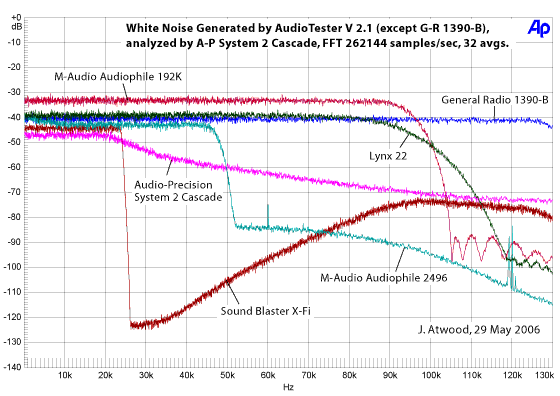
This report is licesnsed by the Creative Commons Attribution-NoDerivs 2.5 license.
The goal for this evaluation was to test various sound cards with the intention of using them as D/A and A/D converters for sound testing software running on a PC. Since it was going to be permanently installed in a system, I chose PCI cards. The target system is a Shuttle-X SN85G4 V2 with a FN85 motherboard. The chipset is the Nvidia nForce3 and the CPU is an AMD Athlon 3200+ (2.2GHz) with 1 Gbyte of RAM. This is a very compact PC with provision for 1 CD/DVD drive, hard-drive, AGP video slot and PCI slot. The OS is Windows XP Professional. The test software is "AudioTester", a shareware program that acts both a generator and analyzer on a PC. It costs 35 euros.
My main piece of audio test equipment is an Audio Precision System Two which has been upgraded to the "Cascade" model (model SYS-2522). This has high-quality analog generators and analyzers as well as digital converters and interface, hence their term "dual-domain" to describe this instrument. It is controlled by an external PC running APWIN software. There are internal DSPs which allow sophisticated digital processing. For convenience, it will be called just the "Audio Precision" or "A-P" from now on. There are actually two sets of converters: a "high-resolution" 24-bit converter that can sample up to 100KHz and a "high-bandwidth" 16-bit converter that samples up to 262KHz. The high-resolution converter was used where possible, but for the 192KHz tests, the high-bandwidth converter had to be used.
The Audio Precision plots were captured by "printing" them to the Adobe PDFWriter. The pdf file was then opened in Adobe Illustrator where the plot lines were colored and comments added. No data was altered. The resulting ".ai" file was then opened in Adobe Photoshop at an appropriate image size, then saved as a .gif or .png file. For plots from the AudioTester software, a bit-mapped screen capture was taken, edited in Photoshop to add text, then saved as a .png file.
The cards tested are:
- Lynx22 (the Lynx TWO was also tested and is essentially the same performance)
- M-Audio Audiophile 2496
- M-Audio Audiophile 192K
- Sound Blaster X-Fi
The Lynx22 lists for $749 but usually sells for a little over $600. The M-Audio 192K lists for $199, but typically sells for about $139. The M-Audio 2496 lists for $139 and typically sells for about $100. (Note: the M-Audio 2496 card tested was about 3 years old - newer cards may be different). The Sound Blaster X-Fi model tested was the basic model (there are now various enhanced versions, such as the "XtremeGamer" and "Platimum PCI 7.1") and sells from $100 to $130.
These are capable of 192KHz sample rates, except the M-Audio 2496, which is limited to a 96KHz sample rate. Each card was installed with its supplied drivers. The generating and monitoring software is AudioTester V2.1, a shareware program available from www.audiotester.de. In all cases, I was able to get AudioTester to talk to the cards, although not without some fiddling with settings.
When mounted in the only PCI slot in the Shuttle PC, the sound cards are right up against the AGP video card. I made a sheet aluminum shield, with tape for insulation, which I placed between the cards. With the shield grounded and in place, there was a slight drop in the noise floor and residual spurs, so all tests were done with the shield in place.
One note on the test methodology: I took 32 samples and averaged them. I did spot checks of the differences between the left and right channels an found that the only difference was a few dB in the even harmonic levels. This might be due to differences in the slew rate between channels. Running the tests over again showed that the tests were quite repeatable.
D/A White Noise Test
First I tested the output bandwidth of the D/A converters. A lot of sound cards filter the output above 20KHz, but for instrumentation use, it is essential that the bandwidth extend to close to the Nyquist frequency (1/2 the sample rate). Each card was connected to the input of the Audio Precision. The FFT analysis mode was selected with the so-called high-bandwidth converter, sampling at 262.144KHz. The FFT modes selected are: 16384 samples, Rife-Vincent 4 sampling window, asynchronous (Power spectrum), and 32 averages.
The AudioTester software was set to "White Noise" at a level of -2.5dB. Each card had fairly different standard output levels, but since this test is just for gross frequency response, the absolute level wasn't important. Each card or the A-P was set for the highest sample rate possible. Also added to the mix is the General Radio 1390-B Random Noise Generator. This was set to the "500KHz" mode and about 2.5Vrms output. This is here, since it will be used for testing the A/D input frequency response later. Also added is the response of the Audio Precision's own white noise generator. It was the poor performance of this generator that prompted me to pull the 1390-B out of the closet and use it as a flat white noise standard.
Here is a composite graph of the white noise response:

Comments on the graph above:
1. The General Radio 1390-B was perfectly flat until just before the Audio Precision's Nyquist frequency - quite good overall! Triode fans should note that the 1390-B uses a 6D4 thyratron immersed in a strong magnetic field to generate the white noise. The output amplifiers are 6AQ5s.
2. The Audio Precision's own white noise generator has a gentle fall-off over 20KHz. According to the Audio Precision documentation, the white noise generator is bandwidth-limited over 23KHz to "maximize the noise energy falling within the audio band". Since the generator is capable of fairly high output voltages (20Vrms in differential mode), the bandwidth limitation is probably to keep the output amps from slew-rate limiting. In any case, this makes the A-P white noise generator useless for this test.
3. Lynx22 - There is a gentle fall-off in response over 75KHz with about 60dB attenuation at 130KHz. This is probably a good response for audio recording at 192KHz sample rates.
4. M-Audio Audiophile 2496 - This has a slight droop between 0 and 10KHz, but is otherwise flat to about 45KHz. The stop-band response isn't too good - about -43dB, and there are anomalous spikes at 60 and 120KHz.
5. M-Audio Audiophile 192K - Very flat up to 90KHz with a stop-band response of about -55dB. Probably the best for instrumentation use.
6. Sound Blaster X-Fi - Although running at 192KHz, there is a sharp -80dB cutoff at 24KHz. However, the stop band rises to -30dB at 100KHz. Useless for instrumentation, although OK for playing video games or playing Red-Book CDs.
A/D Converter Frequency Response
Now for a more detailed examination of the A/D frequency response. The test set-up is the same as before, with the General Radio 1390-B Random Noise Generator feeding a white noise signal to the right input of each card under test. The sensitivity of each card varied, but for this frequency response test, the absolute level isn't important. The output level of the 1390-B had to be reduced for a few cards, since the peaks were overloading the cards (as indicated by the "OVER" indicator in the AudioTester software).
The plots below were taken from screen captures of the AudioTester display. The cards were set to sample at 192KHz, 24 bits, except for the M-Audio 2496 card, was was set to 96KHz. The FFT was set to 8192 bins, "Rife-Vinc3" window, and 32 averages. The random variations in the curves are due to the random noise and don't reflect the detailed frequency response. The AudioTester frequency display seems to only come with a log scale.
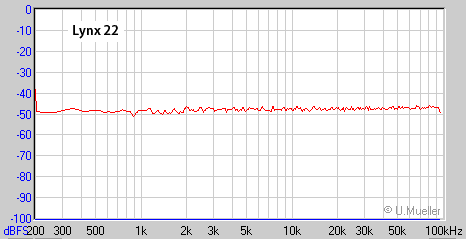
Lynx22 - Nice and flat right up to the Nyquist frequency.
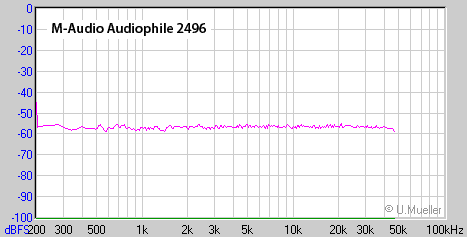
M-Audio Audiophile 2496 - Flat, with a slight drop just before the lower Nyquist frequency of 96KHz.
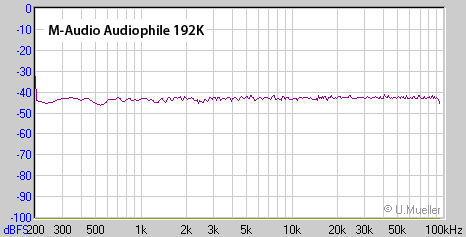
M-Audio Audiophile 192K - Flat to the Nyquist frequency, with a just a slight droop just before cut-off.
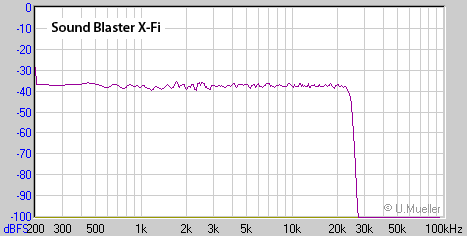
Sound Blaster X-Fi - Sharp cutoff above about 22KHz. Notice the purple line continues to 96KHz, showing that the card is actually sampling at 192KHz.
D/A Distortion and Noise
The distortion characteristics of the D/A converters on the different sound cards will now be examined. Measurements were done at three frequencies: 100Hz, 1KHz, and 10KHz. This was done to see the effects of hum, slew rate limiting, etc. The same Audio Precision FFT set-up was used as before, except for the 100Hz and 1KHz tests, where the High-Resolution converter was used, sampling at 65,536Hz.
Since absolute levels are important for distortion tests, it was decided to run each sound card at -1dB from its maximum output. This ranged from 0.9V to 3.4Vrms. The plots are normalized so that the test signal is always at 0dB.
This test also measured the zero-signal output noise of the sound cards. The AudioTester generator was turned off, so any residual noise or signals would be the result of the sound card output stages, the interconnect wiring, and the input noise of the Audio Precision. The balanced input of the Audio Precision was used to reduce common-mode noise.
Before doing these test, it was important to test the residual noise and distortion of the Audio Precision. The balanced output of the high-precision analog sine wave generator was fed into the analyzer input. The signal level was 1.75V - similar in range to the sound card signals. The test results are plotted below.
Now for the analysis:
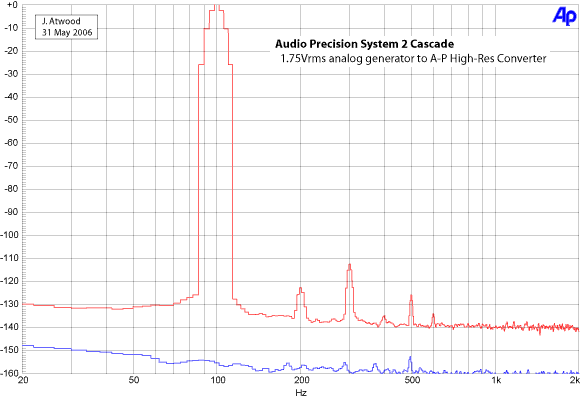
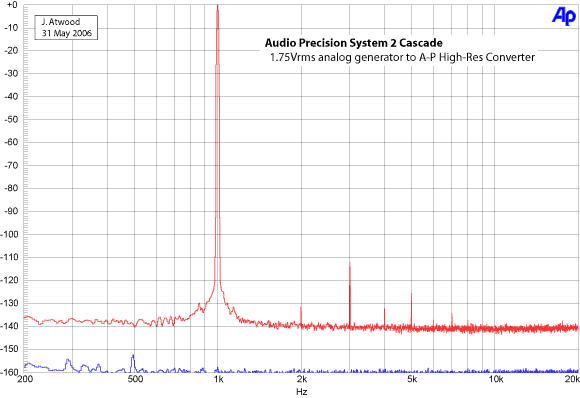
100Hz, 1KHz - The log scale spreads out the bins at low frequencies. The harmonic signature is similar in both plots, with the worst distortion being the 3rd harmonic, which is about -112dB down. This is could be due to either the generator or the Audip Precision input circuits. The noise floor could be partially from the generator and partially from the A/D converter. Note the phase noise a few hundred Hz around the 1KHz signal. This phase noise is absent in the digital converter outputs. There is virtually no hum. The noise floor rises slightly below about 200Hz.
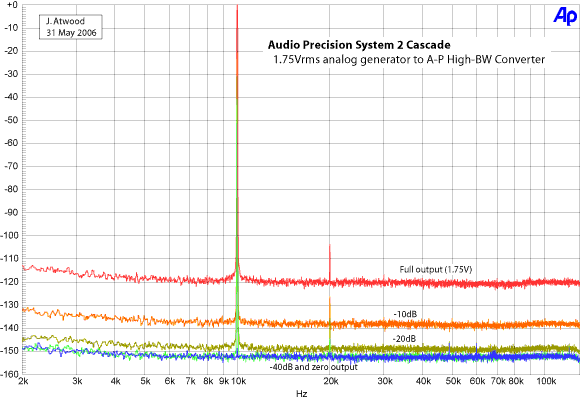
10KHz - A different A/D converter is used here, one with less resolution. This time the 2nd harmonic is dominant and the 3rd harmonic is near the noise floor of -120dB. However, when there is no signal, the noise floor drops to -150dB! To investigate this more, I ran the FFT with lower signal levels - -10dB (down from 1.75V), -20dB, and -40dB. As the 10KHz signal dropped, the noise floor quickly dropped to the point that at -40dB, the noise floor was identical to the zero-signal floor. At first I though that this might be the noise floor of the generator getting reduced as the output attenuators are switched-in. However, at 20KHz and full output, the noise floor is at -120dB for the High-BW converter and -140dB for the High-Res converter. So, it appear that this rise in noise floor is occurring in the A/D converter of the Audio Precision as the signal approaches high levels.
Its outputs were set to the "-10dB" mode and the sampling rate to 96KHz.
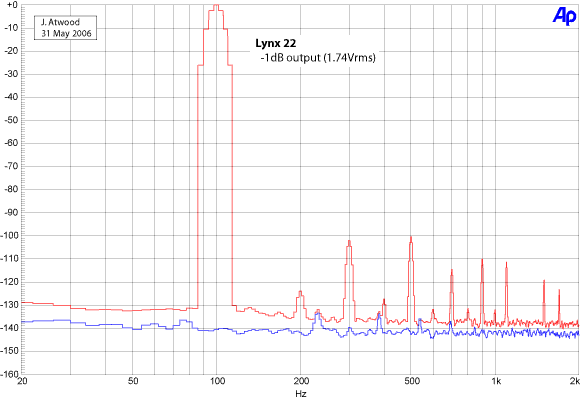
100Hz - Noise floor approaches -137dB but there are significant odd order harmonics. The 5th is worst at -100dB and the 3rd is just below at about -102dB. No trace of hum.
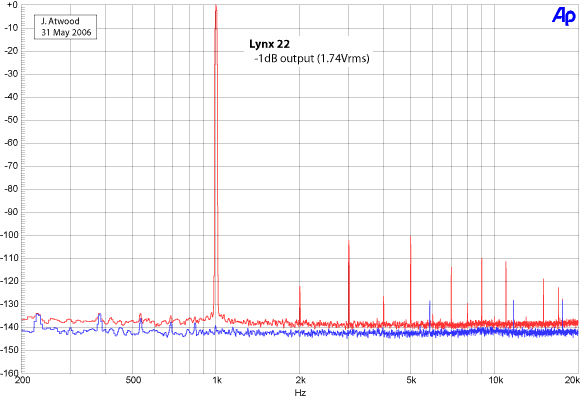
1KHz - The noise floor is even at -137dB and the zero-signal noise floor isn't much lower. The odd-order harmonics are still there. There are a few spurious signals in the zero-signal case.
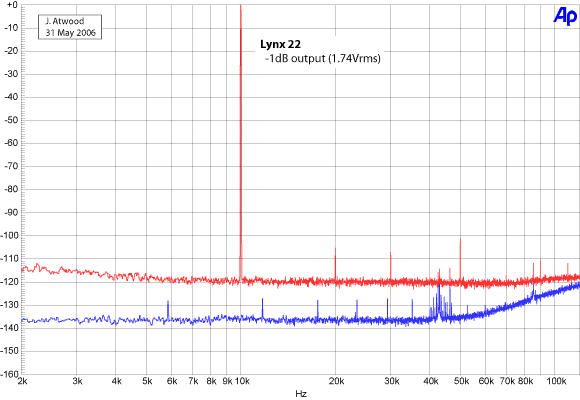
10KHz - The noise floor with signal is -120dB, just as in the Audio-Precision test case, but the zero-signal noise floor is -136dB. This is probably from the sound card. The harmonics are less, although the 5th is still the strongest. With zero signal, there are some miscellaneous spurious signals and a bunch of hash near 43KHz.
When I first noticed the high harmonic distortion on the output of the Lynx22 card, I checked the Lynx TWO card (basically the same as the Lynx22 but with four channels), and found the distortion virtually the same. There was about a two year difference in date codes between the two boards.
M-Audio Audiophile 2496
The sampling rate was 96KHz, and the output at -1dB was 1.04Vrms. The test results are below.
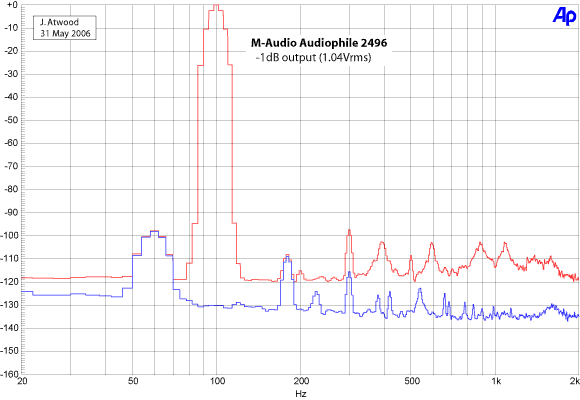
100Hz - There is significant 60Hz and 180Hz hum. (This card has unbalanced RCA outputs, so, despite the balanced input of the Audio Precision, there are still chances for ground loops.) The 3rd harmonic is highest at about -97dB.
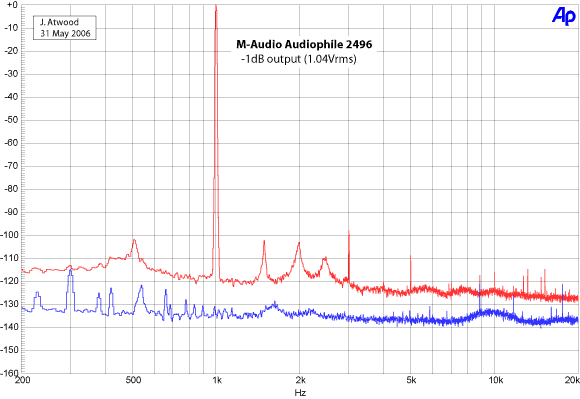
1KHz - The noise floor varies from -115 to -125dB. The 3rd harmonic is -97dB and the 5th is -109dB. There are broad signals at 500, 1Khz and 1.5KHz - these will be explained in the next section. The zero-signal case has significant spurs at about 9, 11, and 18KHz.
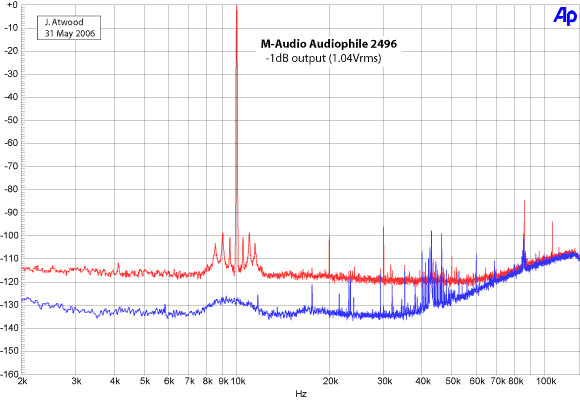
10KHz - The harmonic distortion is similar to the 1KHz case, but with the addition of a 2nd harmonic at -99dB. The real interesting thing is the symmetrical set of side-bands around the 10KHz signal. These are apparent in the 1KHz case, too, as described above. This indicates that the output signal is being amplitude modulated by this 500, 1K, and 1.5KHz ensemble. There is a lot of hash in the zero-signal case just below the Nyquist frequency, and the noise floor rises above 40KHz to about -105dB.
The sampling rate was 96KHz and the -1dB output was 3.44Vrms. The test results are below.
Analysis:
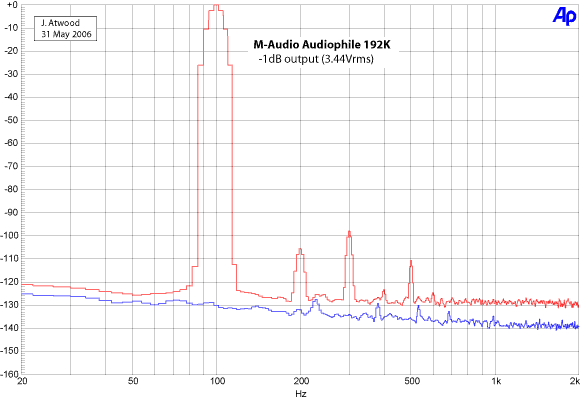
100Hz - Virtually no hum (this card has balanced inputs and outputs). The major harmonics are: 3rd -98dB, 2nd -106dB, 5th and 7th -111dB.
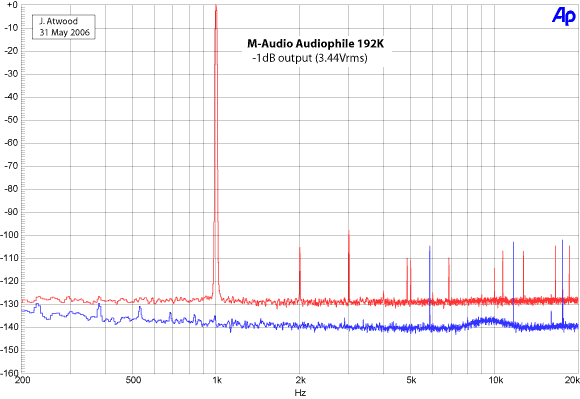
1KHz - The noise floor is about -128dB with signal and -140db without signal. The major harmonics are: 3rd -98dB, 2nd -105dB, 5th and 7th -110dB. There are also some non-harmonic spurs in the -102 to -115dB range. Although not clear from the plot, the major spurs at around 5.9, 11, and 18KHz for zero-signal also exist at the same amplitude in the 1KHz signal case.
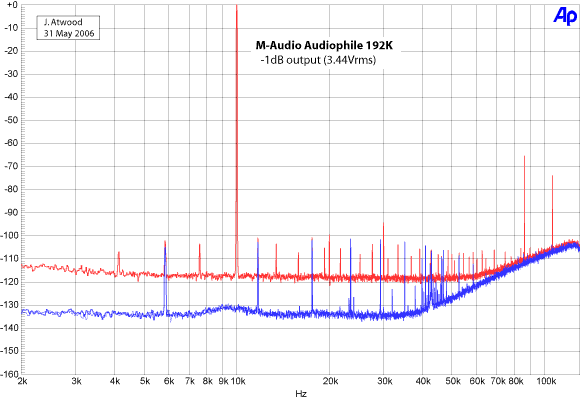
10KHz - Lots of spurs below -100dB, but the one at 30KHz is -94dB and the one at 86KHz is -66dB. This is above the Nyquist frequency, but could still cause problems is some circuits. There is an odd bump in the noise floor around 9.5KHz.
The sampling rate was 96KHz and the -1dB output was 0.960Vrms. The test results are below.
Analysis:
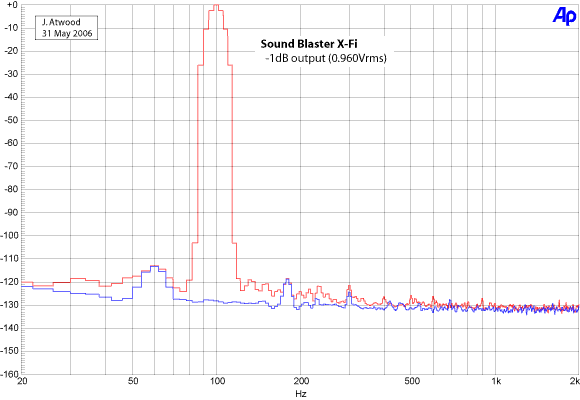
100Hz - Slight hum at 60 and 180Hz (this card has unbalanced inputs and outputs). Practically no harmonics - only the 3rd is visible at -112dB.
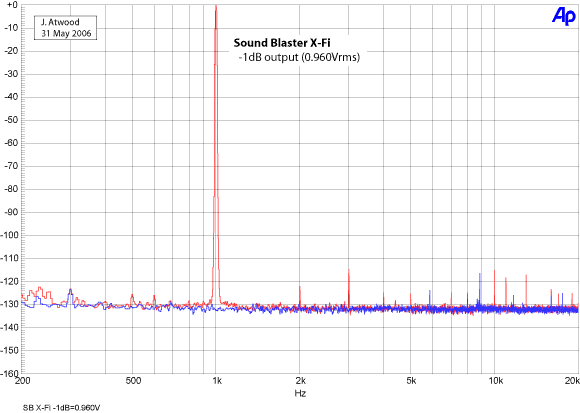
1KHz - The highest harmonic is the 3rd at -115dB. There are some spurs in the 6-20KHz range that are as large as -115dB. Interestingly, the zero-signal noise floor is virtually the same as the signal case: -132dB.
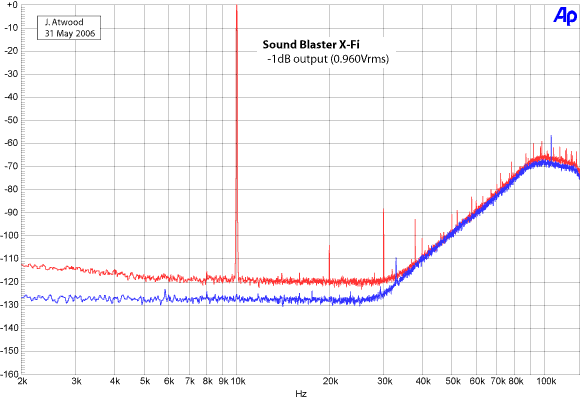
10KHz - The 3rd harmonc has increased to -88dB, the 2nd to -105dB, and the is a -93dB spur at 30KHz. There is an ominous rise in the noise floor, peaking at -66dB at 100KHz.
The Lynx 22 card is quite good, but the harmonic response is higher than desired, especially in the high-order terms.
The M-Audio 2496 card has too much hum, unusual side-bands and somewhat high harmonics and spurs. It may be fine for less demanding applications.
The M-Audio 192K card is a definite improvement over the 2496 card, especially in the hum and side-bands.
The Sound-Blaster X-Fi did the best overall in low harmonics and spurious signals. If one can live with the 24KHz bandwidth limit and single-ended I/O, this would probably be the best sounding of the bunch.
A/D Converter Distortion and Noise
Now for the final set of tests: distortion and noise characteristics of the A/D converters. The analog sine-wave generator of the Audio Precision was used as the source, driven through the balanced, floating outputs. For each card, the maximum input before overload was experimentally determined, then the sine-wave generator was set to -1dB below this maximum signal level. (BTW, it was found on most cards that as the signal got within 1/2dB or so of the clipping level, the distortion went up dramatically, even though the converter was not clipping.) This test signal level is given in each plot.
As before, a full signal and zero-signal test is displayed on each plot. The plots were screen captures from the AudioTester screen. The AudioTester FFT mode was the same as in previous tests, except set to 32,768 bins. All cards were set to 96KHz sampling, except where noted.
In all cases, there is negligable hum. This is mainly due to the floating balanced outputs of the Audio-Precision. When a "grounded" output was used with the cards with single-ended inputs (M-Audio 2496 and S-B X-Fi), there was significant hum.
Lynx 22
This card has two I/O signal level settings: -10dB and +4dB. This is set by relays on the board, and presumably insert an attenuator in the +4dB mode. The -10dB mode is intended for "prosumer" or home studio equipment signal levels, while the +4dB mode is compatible with pro-audio signal levels. The tests were done in the -10dB mode, except where noted. The plots are below.
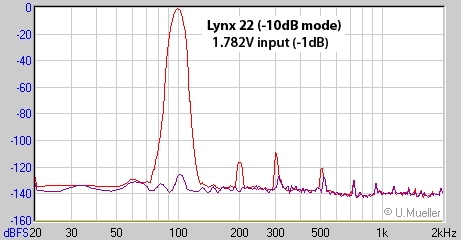
100Hz - The noise floor is about -140dB. The harmonics in descending amplitude are: 3rd -110dB, 2nd -116dB, 5th -120dB. The spurs are at about -130dB or below.
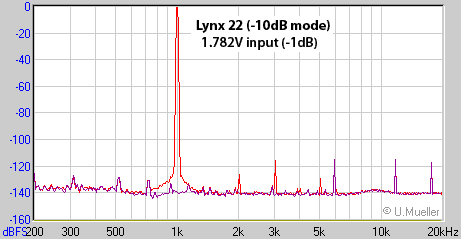
1KHz (-10dB mode) - The harmonics are similar to the 100Hz case, just a little lower. However, the spurs at 6, 11, and 18KHz are at about -115dB.
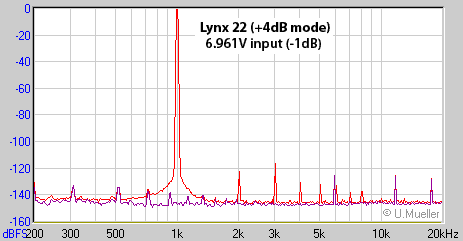
1KHz (+4dB mode) - The spurs and noise floor are about 12dB down. This implies that they are originating ahead of the attenuator, so are coming from the analog front-end. The 3rd and 5th harmonics are the same. These are probably coming from the generator. The 2nd and 4th are higher - these may well be coming from the front-end circuits.
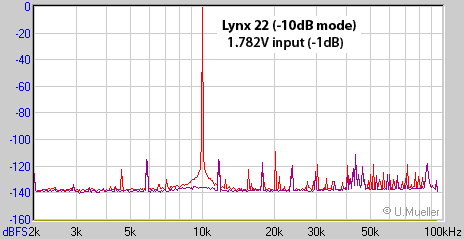
10KHz - Since the Lynx22 card can sample at 192KHz, it seemed worthwhile to look at the 10KHz and higher response. Everything was the same as before, but the sample rate was increased to 192KHz. The 2nd harmonic has jumped to -108dB and there are some non-harmonic spurs present only when the signal is present. The zero-signal spurs are numerous, especially around 44 and 88KHz.
M-Audio Audiophile 2496
Since this card only goes up to 96KHz sampling, only the 10Hz and 1KHz tests were done. The test results are below:
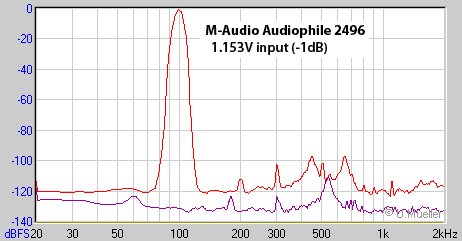
100Hz - The 3rd and 5th harmonics are just below -100dB, however, there are broad spurs around 450 and 650Hz at about -97dB. The noise floor is around -120dB with signal, but drops by 10 to 20dB with no signal.
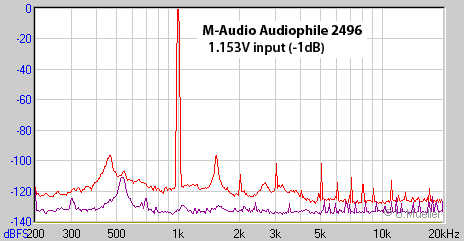
1KHz - The harmonics are similar to the 100Hz case. The noise floor is lower above 4KHz but wtih significant spurs.
Note: This is the only board that shares the A/D and D/A converter on the same chip (an AKM AK2487). It is interesting to note that the broad spurious responses are present on both the A/D and D/A tests for this board. Maybe poor power supply filtering or chip bypassing is the cause?
M-Audio Audiophile 192K:
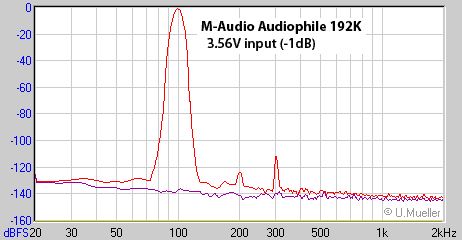
100Hz - Quite a low noise floor (-145dB at the higher frequencies) that doesn't change much between signal and no signal. The main harmonic is the 3rd at -112dB.
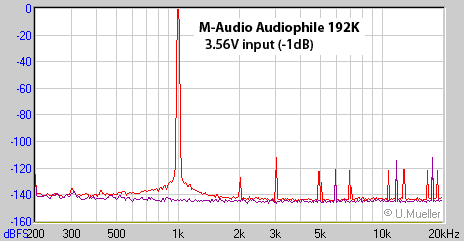
1KHz - Again, a low noise floor. The 3rd harmonic is about the same as the 100Hz case, but the 2nd, 5th and 7th are approaching -120dB. There are spurs above 10KHz as high as -111dB.
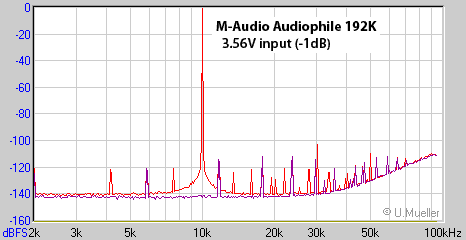
10KHz - Some non-harmonic spurs between -110 and -120dB. The 3rd harmonic is -103dB. The noise floor starts to rise above 25KHz.
Sound Blaster X-Fi
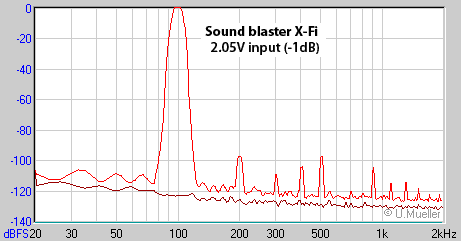
100Hz - The dominant harmonics are the 2nd and 5th at -97dB, followed by 4th and 9th at -104dB and the 3rd at -110dB. The noise floor is about -125dB at 2KHz rising to about -110dB at 20Hz. There are no spurs.
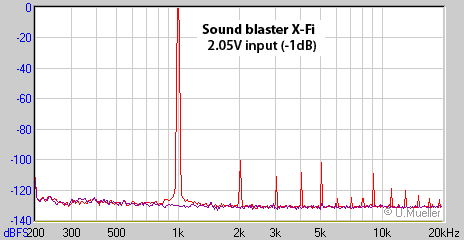
1KHz - The harmonics are similar to the 100Hz case, but several dB lower, overall. The noise floor is flat at -130dB and doesn't change with signal level. Again, there are no non-harmonic spurs.
Conclusions
There are definitely some good sound cards on the market that are quite useable for audio testing. As time goes on, the cheap cards should get better and the better cards will get cheaper. Here are my card-by-card conclusions:
Lynx22 - Well-behaved with good attributes like balanced I/O, XLR connectors, and a good "mixer" software package. It is the most expensive of the bunch. The main complaint: too high harmonic distortion on the D/A outputs.
M-Audio 2496 - Moderate performance - limited to 96KHz sample rate. Marred by high hum level and high spurious signals on both the inputs and outputs.
M-Audio 192K - Much better performance than the M-Audio 2496. Balanced inputs. Generally very good performance, but rather high harmonics and spurs on the D/A output.
Sound Blaster X-Fi - The built-in band limiting at 24KHz and rising noise floor above that make the card useless for wide-frequency testing. However, it had the best distortion performance and very low spurious signals on both inputs and outputs. This should probably be the best sounding card of the bunch.
For the best card to be used for instrumentation, based on the limited tests I did (just 4 cards), I'd pick either the Lynx22 or the M-Audio 192K. Both have balanced inputs. I didn't test the common-mode rejection, but for what its worth, the Lynx22 has INA137 instrumentation input amplifiers on its inputs while the 192K uses conventional op-amps. The PC board layout of the Lynx cards is superb - a 4-layer board with very careful sectionalizing and in the analog sections the signal traces are run on the inside, the power and ground on the outside. This might explain the Lynx card's lower noise floor. On both cards the output harmonic distortion is higher than desired. For critical tests this could be reduced by passive filters.
Appendix: Hardware Analysis
For some comparisons of the hardware on the various sound cards tested, I did a careful examination of each board and noted the chips and connectors used. If you are interested in a particular board, it is worthwhile to download the data sheets for the D/A and A/D converters used in the board.
Lynx 22
I/O - XLR connectors, balanced
A/D Converter - AKM AK5394A
D/A Converter - Cirrus CS4396
Input Op-Amps - INA137, OPA2227, MC33078
Output Op-Amps - OPA2227, 2 x OP275M-Audio Audiophile 2496
I/O - RCA, unbalanced
A/D Converter - AKM AK2487
D/A Converter - AKM AK2487
Input Op-Amps - JRC 5532
Output Op-Amps - JRC 5532M-Audio Audiophile 192K
I/O - 1/4" phone, balanced
A/D Converter - AKM AK5385
D/A Converter - AKM AK4358
Input Op-Amps - JRC 5532
Output Op-Amps - JRC 5532Sound Blaster X-Fi
I/O - 1/8" stereo phone, unbalanced
A/D Converter - Wolfson WM8775
D/A Converter - Cirrus CS4382
Input Op-Amps - MC33078
Output Op-Amps - STL 4558
The PC board layout of the Lynx cards is superb - a 4-layer board with very careful sectionalizing and in the analog sections the signal traces are run on the inside, the power and ground on the outside. This might explain the Lynx card's lower noise floor. All the other cards used 2-layer boards.
Note: please post any questions, comments, or corrections to this blogpost at the ClariSonus blog.